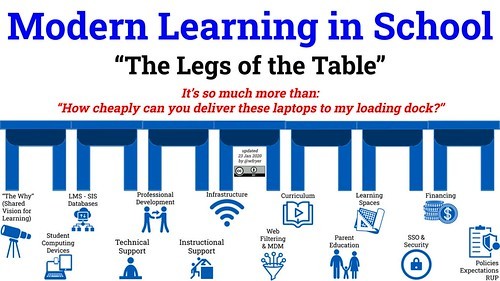e-Learning Ecologies MOOC’s Updates
Ubiquitous Learning: where the atmosphere (also) matters
As computing has become ubiquitous so has learning. The perspective of computing (and technology) as a service, assumes a practical approach in most diverse areas such as health, agriculture, and mainly education.
Ubiquitous learning (u-learning) represents a paradigm that has emerged, so users can experience and accomplish meaningful learning (Cárdenas-Robledo and Peña-Ayala, 2018), transcending the old pedagogical separations of space and time (Cope and Kalantzis, 2017).
Tools such as Google Classroom, Moodle, and Edmondo to name a few are strongly used as virtual classrooms to foster the situation of ubiquitous learning. Advantages including permanency, accessibility, immediacy, interactivity, the situation of instructional activities, and adaptability endorse the adoption of u-learning (Ma and Yu, 2019). However, socioeconomic and even family structure might affect the outcomes proposed by this learning approach.
As teachers need to reinvent teaching methodologies, parents assume an important role in this process as well. From surveillance kids' commitment to the proposed tasks and activities to providing an adequate environment for the learning, parents also face responsibilities in this entire context. It becomes even more urgent in times like these, where COVID-19 has forced the whole learning-teaching-family structure to be reorganized.
https://www.cbc.ca/news/canada/british-columbia/covid-19-online-learning-home-1.5528953
On the other hand, socioeconomic conditions develop a huge impact too. At low-income homes, the lack of appropriate infrastructure required to access tasks and assignments lead to inequality among students' progress. Nevertheless, although fortunate families may dispose of equipment for an appropriate leaning, a healthy environment is not only about material, but also interpersonal relationships.
The potential u-learning delivers is undeniable. Notwithstanding, at this point, developing economies and especially the least developed countries fight against a big amount of issues, where the most sophisticated solutions depend on education. As a teacher, I get even more enthusiastic when reading about the possibilities u-learning offers, but also feel motivated on how this entire ecosystem can reach and be adapted to the most students' family-and-social different ecosystems.
References:
Cárdenas-Robledo, L. and Peña-Ayala, A., 2018. Ubiquitous learning: A systematic review. Telematics and Informatics, 35(5), pp.1097-1132.
Cope, B., and Kalantzis, M. (2017). Conceptualizing e-learning. In B. Cope and M. Kalantzis (Eds), e-Learning Ecologies. New York: Routledge.
Ma, L.F.H., & Yu, L.L. (2019). Ubiquitous Learning for Distance Education Students: The Experience of Conducting Real-Time Online Library Instruction Programs through Mobile Technology. International Journal of Librarianship, 4(1), 93-102.



Great point about both inequality in accessing technology and the broader learning environment a learner has(the interpersonal relationships you mention). To me it is also important to highlight that the problem of techonoly-illiteracy and later the need for skills upgrade for both teachers and guardians will be broader as technology evolves so fast. In order for teachers to understand, use and teach about new technologies they will need very often to upgrade their skills. Same for guardians that will need to exercise some form of control over the technology that is accessible to their kids.
This constant need of upgrading concerns us all, @Eleni Tsaireli, as you highlighted so well. Thanks for contributing to the discussion.
I am a teacher in a US public high school and I have also been facing the inequities of home learning for students. Initially after we switched to home learning, the main focus had been on getting devices and internet access for students. However, there is still a great deal of inequity in the technological backgrounds of students and even between teachers. Teachers are also estimating the time involved in students completing tasks, but there are so many problems that students face when they try to complete tasks. For example, my son's teacher sent a video and our first 2 devices would not play the video but finally the third did. In this one example, you see the struggle and the parent involvement in supporting learning, as you clearly pointed out. I appreciated the legs image because this is a very complex task and simply getting kids access to devices does not make for a quality education. We have very far to go and I hope that public school spaces begin to invest in the professional development and infrastructure that will help develop a more appropriate learning platform and experience.
Hi @Rebecca Latour!
I couldn’t agree more with you. If governments have thought just remote learning could handle this entire situation properly, it has been proved otherwise. Professional development should be a must-have, especially after this crisis. Thanks for bringing that aspect up!
Hello @Humberto Cunha,
This update highlights a relevant issue that is the asymmetry between students' access to u-technologies. In addition, it is interesting to note how the family environment is an essential factor in the learning process by the learners.
Looking at it this way, it may be possible to think of scenarios in which not only the figure of the teacher joins the learning networks together with his students but also a professional psychologist. It is interesting to imagine how the area of educational psychology could deal with the platforms of ubiquitious learning and thus guarantee an improvement in the emotional aspects that surround the learners.
Your comment and assumption are very interesting, @Victor Lucas Cavalcante. Psychology issues are must-haves especially in times like these. They will be even more important after this covid-19 crisis decreases. Students and teachers will not be the same after all this at all. Thanks for the discussion!
I liked this update very much,@Humberto Cunha! As a latinamerican teacher in this COVID-19 context I find that, although we have public virtual learning environments, the reality is that the physical and emotional environments at homes differ a lot and makes this tools unuseful sometimes.
Your writing is very fluid and nice to read.
Cheers!
Thank you so much for your feedback, @Marcela Rondoni! Your comment sums up the idea. The COVID-19 crisis has made socioeconomic differences in education crystal clear. Hope we can all learn how to deal with this situation and its impacts.